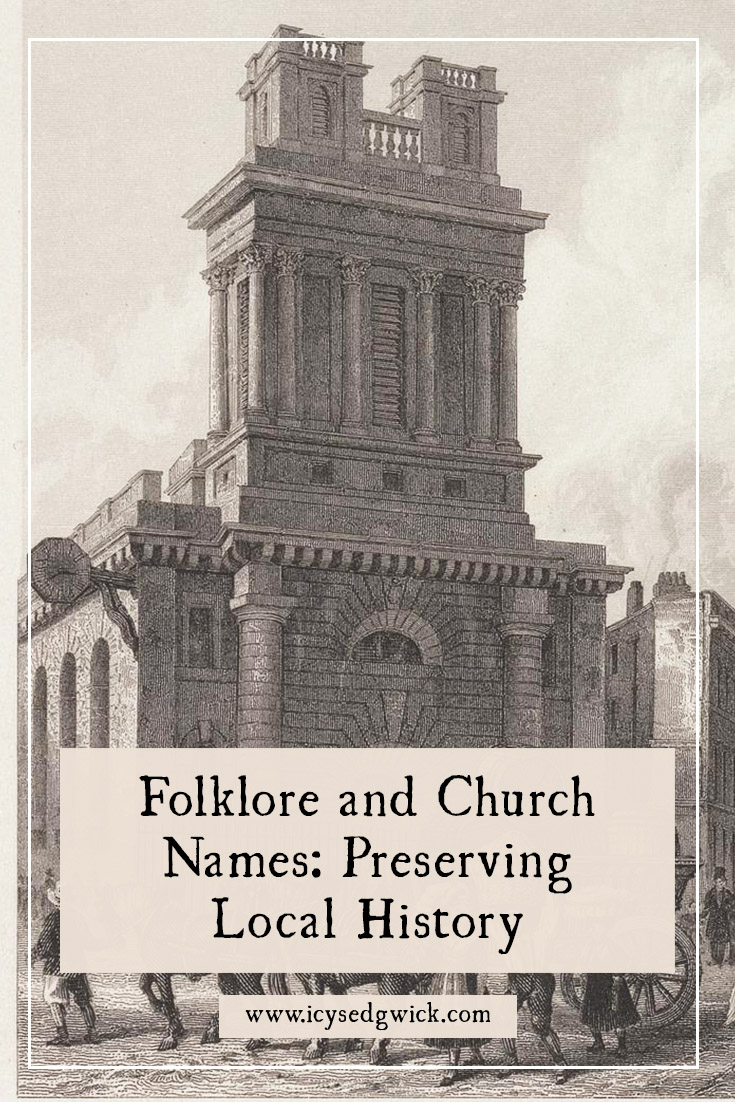I started out with the intention of looking at unusual church names. The problem was, this offered the potential to accidentally poke fun at their congregations. It also didn’t help that most churches in the UK have pretty similar names. They’re named for individual saints, like St Nicholas’ Cathedral in Newcastle, or even all saints like, funnily enough, All Saints. Otherwise, they’re named for their location.
Yet many churches have such names and preserve a touch of their history, or that of their location, through their names – much like pubs. So I thought I’d look at those churches whose names deviate, even slightly, from the usual ‘St Andrew’s Church’ format. So when I say ‘unusual’, that’s what I mean. Not like the usual names, rather than weird or strange!
While we’ve looked at church folklore and haunted churches before, this time, let’s look at some unusual church names!
St Mary Woolnoth, London
The official name of this church on the corner of Lombard Street and King William Street is St Mary of the Nativity, but most people call it St Mary Woolnoth. The church survived the Great Fire of London and the Blitz, but was almost swept away by the City and South London Railway. Rather than losing the entire building, the church only lost the crypt to what is now Bank station. It seems the churchwardens weren’t too sad to lose the crypt since it was closed at one point due to the smell coming from the bodies in the vault. Some suggested there were 7000-8000 bodies under the floor (A London Inheritance 2020).

The current church dates to the early 18th century, designed by architect Nicholas Hawksmoor. This is his only church in the City of London. Hawksmoor was also responsible for Christ Church, Spitalfields, which provided the inspiration for the Ten Bells’ name.
During the building work, workers found Roman remains, which matches evidence of Roman buildings nearby (Historic England, n.d.). Other websites breathlessly describe Saxon remains, though they’re not in the Historic England listing. Before anyone gets excited about Christianity ‘reusing’ earlier sites of worship, there’s a gap of a few centuries between the Saxons and the construction of the original 12th-century church on this site.
So we know where St Mary in the name came from, but what about Woolnoth? In 1191, a record named the church ‘Wilnotmaricherche’, which may have been a reference to a 12th-century benefactor. Theories propose Wulfnoth, Wulnot de Walebrok as his name (Young 2017).
Other theories propose a connection with the wool trade, since that was the case with nearby St Mary Woolchurch Haw. The two congregations merged after the Great Fire of London claimed St Mary Woolchurch Haw (Historic England, n.d.). So, could the name ‘Woolnoth’ have been resurrected as a nod to both St Mary Woolchurch and its earliest name? Others suggested in 1812 that the name came from the proximity to the wool market (A London Inheritance 2020).
The Tron Kirk, Edinburgh
The Tron Kirk stands on the Royal Mile in Edinburgh, on the corner of the High Street section and South Bridge, although it’s no longer a working church. The church, or kirk, dates to 1647, commissioned by Charles I. So where does the name come from?

Its official name gives us a clue; Christ’s Kirk at the Tron. The Tron refers to a public weighing beam. The tron dates to a time when city fathers standardised weights so they could properly tax goods. Burghs had their own weights and merchants needed to weigh their goods using these weights to keep everything above board. The word ‘tron’ deries from an Old French word, ‘tronel’, meaning ‘balance’ (SCAN n.d.).
One of Edinburgh’s trons was at the top of the West Bow, used to weigh butter. The other stood outside the church, used to weigh salt, which is where the ‘at the Tron’ part of the official name comes in.
Over time, people shortened the name to ‘The Tron’. The congregation moved out in 1952. Since then, it has been a festival venue, bookshop, tourist information centre, and a boutique artists’ market (SHBT n.d.).
The Italian Chapel, Orkney
This chapel was crafted from two Nissen huts at a former prisoner of war camp on Lamb Holm, Orkney. Winston Churchill ordered that Italian soldiers captured in North Africa be sent to Orkney to help construct barriers at Scapa Flow to secure the area for the home fleet.

Around 550 soldiers ended up on Lamb Holm at Camp 60. They had a camp priest, Fr Giacobazzi, who requested permission to build a chapel. They joined two Nissen huts together and tasked soldier artist Domenico Chiocchetti with the creation of the actual chapel. Two other soldiers, blacksmith Giuseppe Palumbi and cement worker Domenico Buttapasta, helped (Orkney.com n.d.).
Chiocchetti painted the altarpiece, while the soldiers made an altar from concrete and used painted glass in the windows (Wills 2016). Luckily, before the war, Chiocchetti had studied art, and did an apprenticeship to be a church painter. After being captured by Canadian troops in Libya, he ended up in a POW camp in Egypt. There, the English paid him on a commission basis to copy family photographs and paint portraits. When orders came to send the camp to India in 1940, a Scottish corporal intervened and Chiocchetti ended up in Orkney instead (Muir n.d.).

Judging by the photos, it’s a beautiful space, refreshed by restoration artist Antonella Papa. Both its name and presence preserves a slice of WW2 history, making this the most unusual church on this list.
Church of the Good Shepherd, Lullington
This might not sound like a particularly unusual name, but it’s not this church’s original name. Found on the South Downs, the church is Sussex’s smallest church. Seating only twenty people, it’s one of the country’s smallest churches.
As far as anyone can tell, the original church was far larger, but was razed during the English Civil War by Parliamentarian forces (AdOyo 2024). The remaining building is all that remains of that earlier church’s chancel. The vicar holds service by candlelight as the church has no electricity supply.

No one is entirely sure of the church’s original name when it was dedicated in the 13th century. Some think St Zita was the original dedication, canonised her devotion and hard work (Cuckmere Churches n.d.). St Zita lived during the 13th century, and is the patron saint of domestic workers, especially maids. People often appeal to her for help in discovering lost keys.
In one story, Zita was careful to be a good manager of other servants, although she didn’t receive much loyalty from the staff for this. Zita delegated the bread-baking to another servant so she could help someone in need. The other servants told the family, but when they want to admonish Zita, they found angels in the kitchen, doing the baking for Zita (Catholic News Agency n.d.).
Sadly, much of the population fell to the 14th-century Black Death, leaving the congregation at a handful of families (AdOyo 2024).
After community discussions, the church changed its name to the Good Shepherd in 2000, referring to one of the earliest names for Jesus. This reflects the area’s agricultural nature (Cuckmere Churches n.d.).
Watts Cemetery Chapel, Compton
This chapel, made of terracotta and red brick, stands in Compton Cemetery on Down Lane, burial place of author Aldous Huxley. The main reason I wanted to include it is less because of its name being unusual, and more because of whose name it was.
Victorian painter George Frederic Watts funded the chapel, designed by his designer wife Mary Fraser Tytler. Watts was most often associated with the Symbolist movement, but with paintings of Psyche, the Minotaur, nymphs, satyrs, and Death, his work bears some common points with the Pre-Raphaelites I’ve discussed before.
But back to Fraser Tytler. She didn’t make the chapel herself. Oh no, she crowdsourced work from the local community by teaching 78 local people how to make the clay tiles her design needed (vernon 497373e2 2018). Writers sometimes refer to Fraser Tytler as Mary Seton Watts, her married name, so the name of the chapel refers to her as much as her husband.
Then we go inside the chapel. Fraser Tytler opted for a weird blend of Celtic Revival and Art Nouveau style, with angels peering out of a lush, green background.

She’s more often discussed in relation to the Arts and Crafts Movement, but the work inside the chapel feels more Pre-Raphaelite. While the angels are notable with their wings and halos, there’s more of the Edward Burne-Jones about them. The sweeping, sinuous forms are more in keeping with the natural, organic flows of Art Nouveau. As an aesthetic choice goes, she couldn’t have picked a more fitting design for a folklore-adjacent look!
What church names are in your city?
I love the way these church names preserve the stories of their construction or their local area. Far from being ‘unusual’, they’re actually very instructive!
I would love to hear if you’ know of any churches with unusual names, especially if you know how they got their name. It would be interesting to see what names appear and what folklore has become attached to them!
Feel free to leave a comment below if you’ve got any interesting, cool, or weird church names in your neck of the woods.
References
AdOyo (2024), ‘Lullington Church of the Good Shepherd’, Atlas Obscura, https://www.atlasobscura.com/places/lullington-church-of-the-good-shepherd-england. Accessed 27 March 2025.
A London Inheritance (2020), ‘St Mary Woolnoth – The Church with the Underground in the Crypt’, A London Inheritance, https://alondoninheritance.com/london-churches/st-mary-woolnoth-church-underground-crypt/. Accessed 25 March 2025.
Catholic News Agency (no date), ‘St Zita of Lucca’, Catholic News Agency, https://www.catholicnewsagency.com/saint/st-zita-of-lucca-446. Accessed 27 March 2025.
Cuckmere Churches (2020), ‘The Church of the Good Shepherd, Lullington’, Cuckmere Churches, https://cuckmerechurches.org.uk/the-good-shepherd-lullington/. Accessed 27 March 2025.
Historic England (2017), ‘Church of St Mary Woolnoth’, Historic England, https://historicengland.org.uk/listing/the-list/list-entry/1064620?section=official-list-entry. Accessed 23 March 2025.
Muir, Tom (no date), ‘The Italian Chapel’, Orkneyology.com, https://www.orkneyology.com/italian-chapel.html. Accessed 27 March 2025.
Orkney.com (no date), ‘The Italian Chapel’, Orkney.com, https://www.orkney.com/listings/the-italian-chapel. Accessed 27 March 2025.
SCAN (n.d.), ‘Scottish Weights and Measures: Background’, SCAN Weights and Measures Guide, https://web.archive.org/web/20200220223123/http://www.scan.org.uk/measures/background.asp. Accessed 27 March 2025.
SHBT (2017), ‘The Tron’, SHBT, https://www.shbt.org.uk/our-projects/the-tron/. Accessed 25 March 2025.
vernon 497373e2 (2018), ‘Watts Cemetery Chapel’, Atlas Obscura, https://www.atlasobscura.com/places/watts-cemetery-chapel. Accessed 27 March 2025.
Wills, Dixe (2016), ’10 tiny churches around the UK’, The Guardian, https://www.theguardian.com/travel/2016/oct/16/top-10-tiny-churches-in-the-uk. Accessed 25 March 2025.
Young, Nick (2017), ‘How London’s Churches Got Their Unusual Names’, Londonist, https://londonist.com/london/history/how-london-s-weirdest-churches-got-their-names. Accessed 23 March 2025.
Nutty about folklore and want more?
Add your email below and get these posts in your inbox every week.
You'll also get my 5-step guide to protecting your home using folklore!







Have your say!